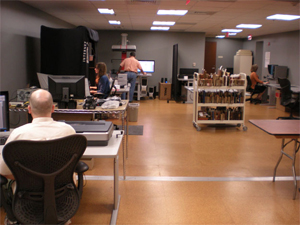Just before leaving Trent Hall, the Conservation staff took advantage of the outdoor space to participate in a paste paper workshop on July 31, 2008. This technique of creating decorative paper using pigments and wheat starch paste is one of the earliest forms used for covers and endpapers. It is commonly found on materials from the 16th to 18th centuries and is still used today.
We used samples from the Jantz collection as inspiration to create, and in some cases re-create, patterns that are both decorative as well as useful for our work. Working outside on a hot and humid summer day was interesting, especially when it rained and we had to move into the women’s restroom in Trent Hall. Luckily for us there was plenty of space in the old dorm restroom to complete our work! Duke University Library staff may read more about this in the September 2008 IB.
In other news, the Conservation Lab has returned to Perkins Library along with the Digital Production Center and Winston Atkins. We moved on August 25-26th, and have been unpacking and settling into our new space. At some point in the near future we hope to have a formal open house to officially open the new lab.


 Continue reading the
Continue reading the 
 It’s Manuscript Day in the lab, similar to
It’s Manuscript Day in the lab, similar to  As you may know we have been working with the Digital Production Center to
As you may know we have been working with the Digital Production Center to 

 My favorite project over the years has been building the Digital Production Center. When I started on March 14, 2005, the Digital Production Center was located on Perkins lower level behind the copy room and was often used as a shortcut from the lower level to the
My favorite project over the years has been building the Digital Production Center. When I started on March 14, 2005, the Digital Production Center was located on Perkins lower level behind the copy room and was often used as a shortcut from the lower level to the 
 Rabbi Meyer was an activist and advocate for human rights during this dark period of Argentine history, and he personally advocated for the release of political prisoners. As part of the collection that we had to digitize, there were many original hand-written letters from prisoners and other original documents filled with gut wrenching testimonies of arrests, incarcerations and torture, and the desperate plight of family members of those disappeared or incarcerated.
Rabbi Meyer was an activist and advocate for human rights during this dark period of Argentine history, and he personally advocated for the release of political prisoners. As part of the collection that we had to digitize, there were many original hand-written letters from prisoners and other original documents filled with gut wrenching testimonies of arrests, incarcerations and torture, and the desperate plight of family members of those disappeared or incarcerated. Alex Marsh is a Digitization Specialist in the
Alex Marsh is a Digitization Specialist in the 